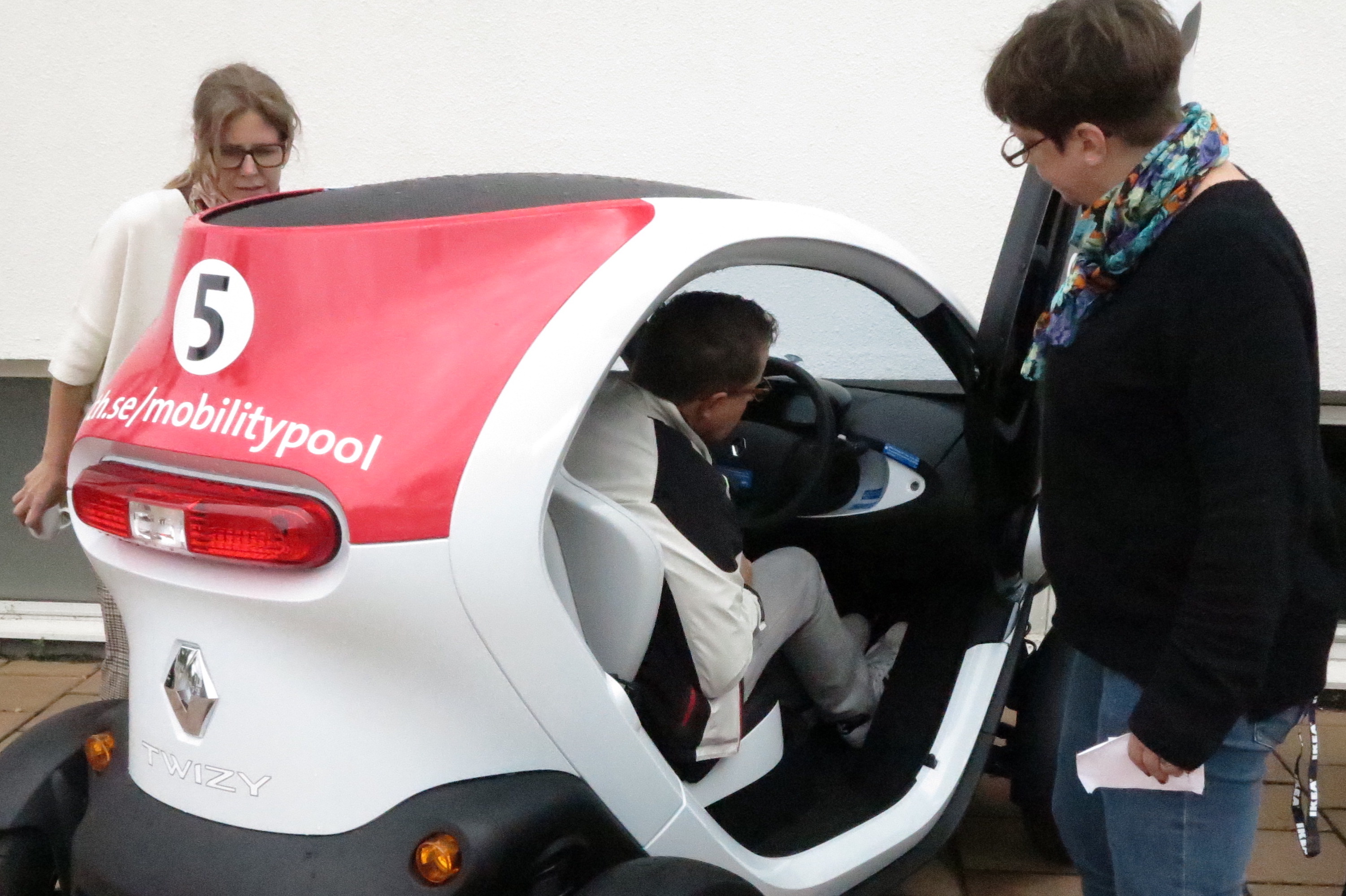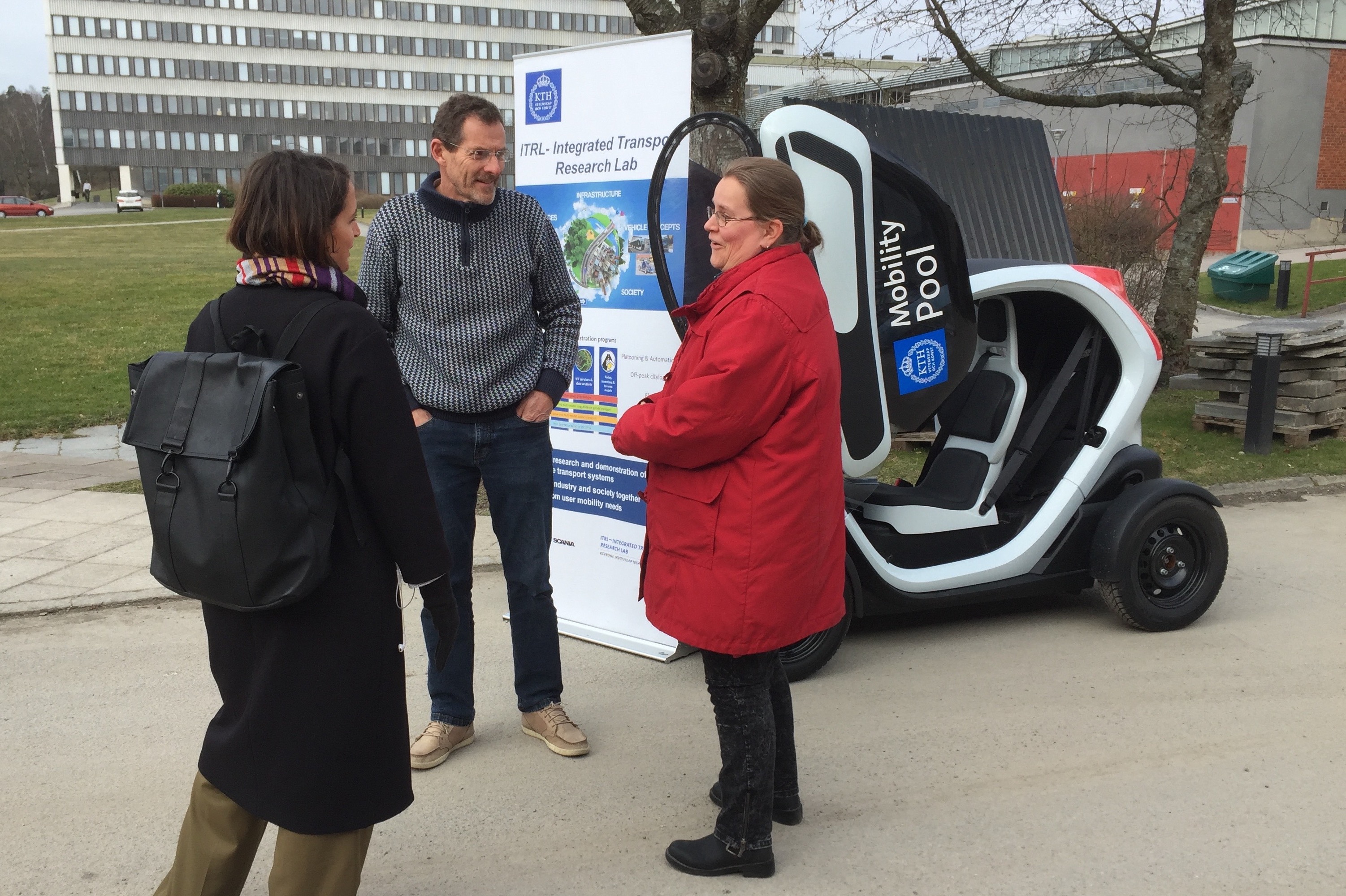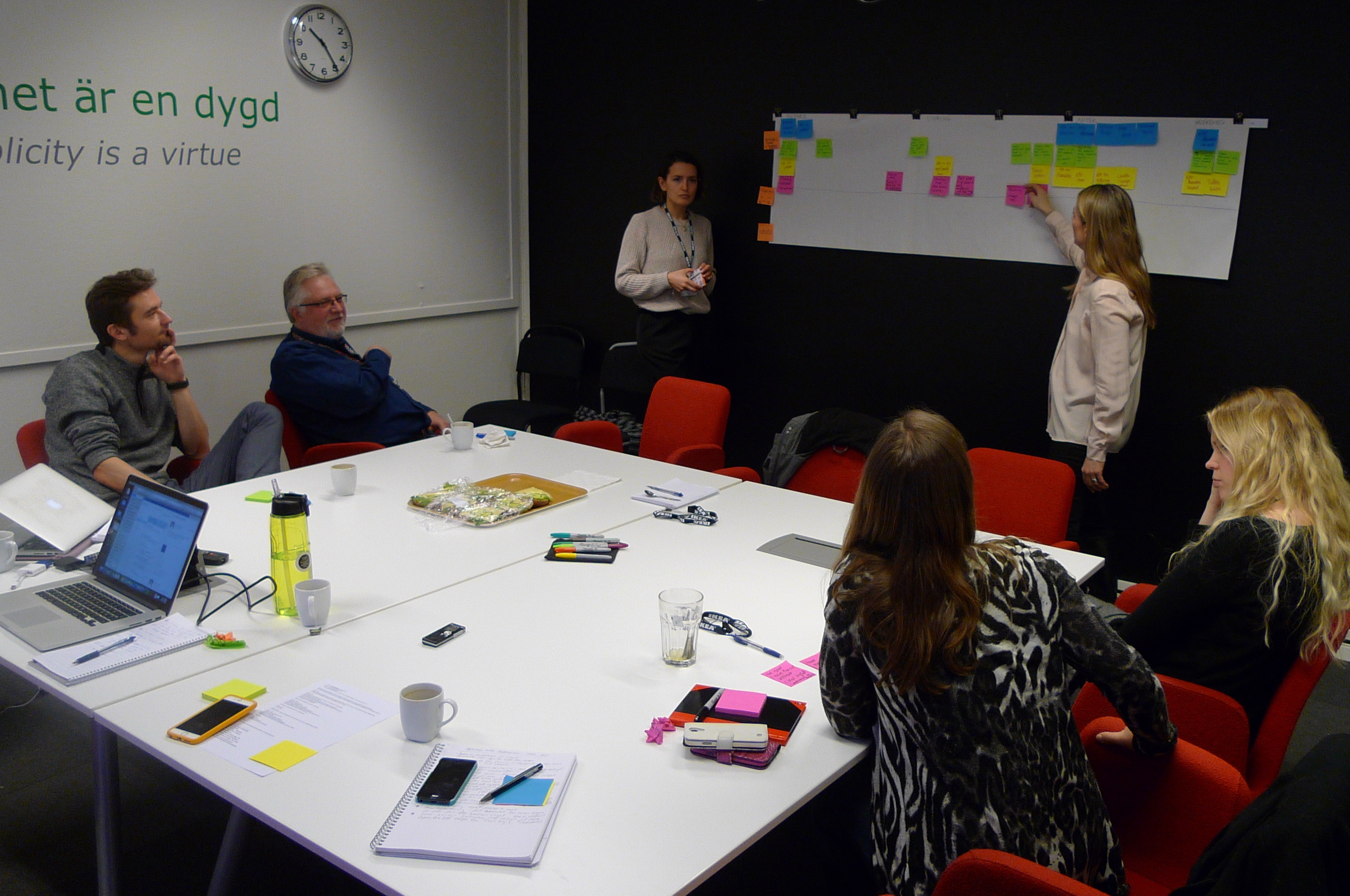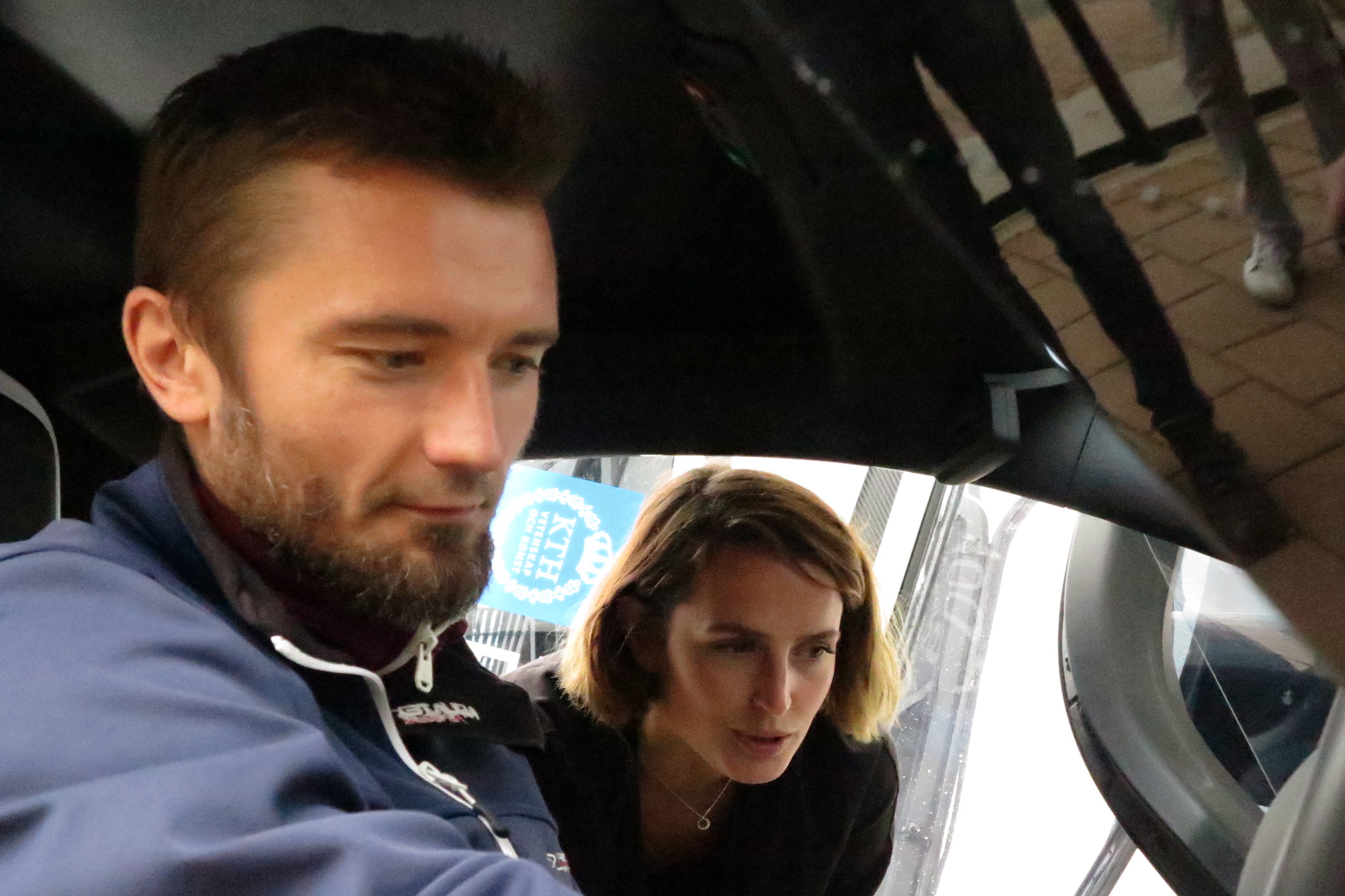KTH Mobility Pool

KTH Mobility Pool was a long-term research project that explored replacing fossil fuel car-based travel to work for employees at two large workplaces in Sweden through a new product-service system (PSS), integrating lightweight electric vehicles (LEVs) in a shared use system, to provide a more sustainable mobility alternative for several different user needs.
Aim
Fossil fuels heavily contribute to the current emission of carbon dioxide. The aim of the Swedish parliament is that Sweden should have a fossil fuel free vehicle fleet in 2030. A change in both people’s mobility practices and type of vehicle used is needed in order to reach this goal. The KTH Mobility project is one puzzle piece in this change.
The Swedish municipality Botkyrka (located in the Greater Stockholm region) and IKEA in Älmhult (in Southern Sweden) are two work locations with the common problem of too many employees commuting by car. The area around the work locations becomes a parking place and the fact that the employees use their private internal combustion engine car for work related errands does not fit into the environmental policies of these organizations.
Commuting to and from work in time and with all the comfort that the private car has to offer has also led to unsustainable practices that generate high traffic flows and peak hours of congestion in urban areas, negative environmental impact from combustion of fossil fuels, as well as increase in the need for parking spaces. Many large workplaces today require huge amount of parking spaces for their employees who prefer private car usage for commuting to work. Two large workplaces in Sweden among many few are trying to encourage the use of public transport in combination with other mobility alternatives such as bicycles and shared mobility services for commuting to and from work as well as during work hours.
A collaborative innovation between diverse actors including users, the project aimed at designing and trying out the solution in real contexts by carrying out trials and co-creating with users as well as the involved actors, which came from both public and private organizations. Being a multi stakeholder project with rather diverse actor backgrounds, the project had multiple goals:
The underlying aims of the project were:
• To test the pool service with light electric vehicles for local transport in urban areas with nearby sparsely populated areas (eg Tumba C and Älmhult) where passenger cars are widely used today as part of everyday life.
• Identifying and describing customer needs and users' everyday practices and needs, which is crucial for developing and designing a well-functioning product and service solution.
• To evaluate the actual climate, environmental and health benefits of the pool solution compared to today's situation.
• To evaluate and develop the product and service solution: users and their practitioners, booking model and vehicle type.
• To inform and influence actors who may wish to drive the project further into the commercial phase.

Approach and method
Within the scope of this project, a pool with light electric vehicles (LEVs) has been tested in Botkyrka and IKEA Älmhult during 6-12 months. The goal was to replace the use of the fossil fuel using cars by these LEVs. The vehicles have space for two persons and have a range of 50-80 km depending on driving behaviour. The pool had two different types of users: daytime users that used the vehicles during working time for meetings, errands, lunches and these were allowed to use the vehicles for both work related and private errands, as well as caretakers that took the car to and from the work every working day. The caretakers were allowed to use the vehicles as if it was their own during weekends and evenings. As a compensation, they were responsible for charging and cleaning the vehicles as well as doing minor maintenance of the vehicle.

The project took a user-centered and service design approach by involving and engaging users from the early stages of the work and throughout the whole process. This was done through setting up two living lab experiments in two geographically different contexts and workplaces, where users lived with the prototyped design for a period of 12 months in each site. Throughout this period, all the actors were actively involved in the experimentation. Particularly users were a critical group by both trying the alternative as well as participating in different workshops where they shared their experiences before, during and after the trial while also providing feedback on the solution from their everyday life perspective.

Both the service system and users became central to the analysis as well as the related aspects around mobility infrastructure such as charging, parking spaces, rules and regulations, and other stakeholders involved in the mobility system. The users of the vehicles were followed using interviews, questionnaires, workshops, diaries as well as measurements of driving data. The feedback of the users and the observations of the project participants were continuously monitored. In addition, numerous workshops were conducted with project stakeholders around core issues emerging from the experiment’s output.
The project consisted of three main phases:
1) Preparation for field trials with concept demonstration and feasibility study with data collection.
2) Implementation of concept demonstration in two half-year stages at two test sites: IKEA Älmhult and Botkyrka municipality, with parallel data collection.
3) Analysis and synthesis of collected data as well as supplementary data collection and concept development together with the project participants.
Brief conclusions
Even though some organizational challenges were faced such as sick leave and finding replacements in case of business trips, the caretakers were satisfied with being caretaker. They tried to replace their private vehicle as much as possible. They thought that the Twizy was fun and nice to drive, which was confirmed by the daytime drivers. The disadvantages of driving the Twizy were e.g. the fact that the sight could be bad in case of humid or cold weather when there was mist and ice formation on the inside of the window. Another issue was that it could feel insecure when driving on motorways. In the municipality of Botkyrka, the vehicles were most often used for business trips, whereas the vehicles were used mostly for going out for lunch at IKEA. This depended both on the needs and culture of the respective organizations.
A more intensive use among the daytime users would have been desirable. The reason why not more people used the Twizy during daytime was that e.g. the caretaker model partly limited the possibility of using the vehicles because this limited the time the vehicles were accessible. The caretaker model also created an insecurity of that the vehicles would be at the right place when they would be needed for meetings etc.
Experiences from the project also contributed to insights on the "important to integrate material" (eg vehicles and IT systems), skills (eg handling of vehicles, systems and services) and infrastructure (eg rules and information) when developing a well-functioning and user-accepted product and service system.
Publications
KTH Mobility Pool Final Report (pdf 4.1 MB)
S. Sopjani et al., "Involving users and user roles in the transition to sustainable mobility systems : The case of light electric vehicle sharing in Sweden," Transportation Research Part F : Traffic Psychology and Behaviour, vol. 71, pp. 207-221, 2019. Diva link
D. Gürdür and S. Liridona, "Visual Analytics to Support the Service Design for Sustainable Mobility," in 2018 IEEE Conference on Technologies for Sustainability, SusTech 2018, 2018, pp. 84-89. Diva link
L. Sopjani et al., "Co-creation with diverse actors for sustainability innovation," in Proceedings of the 21st International Conference on Engineering Design (ICED17), Vol. 8: Human Behaviour in Design, Vancouver, Canada, 21.-25.08.2017, 2017. Diva link
M. Hesselgren, H. Hasselqvist and L. Sopjani, "Design strategies for exploring and bridging : Intersections of everyday life and decisionmaking for sustainability," in Conference proceedings of the Design Management Academy : Research perspectives on creative intersections, 2017, pp. 189-205. Diva link
L. Sopjani et al., "Aligning private and public domains for sustainable disruptive innovation," in Proceedings og 17th International CINet Conference, 2016. Diva link
L. Sopjani, J. Janhager Stier and S. Ritzén, "User involvement in disruptive innovation – A study on users of a light electric vehicle sharing system," in Proceedings of 23rd Innovation and Product Development Management Conference, 2016. Diva link
Project lead and management
Peter Georén
Per Jonas Gyllenspetz
Research group:
Jenny Janhager Stier
Liridona Sopjani
Teo Enlund
Mia Hesselgren
Partners






